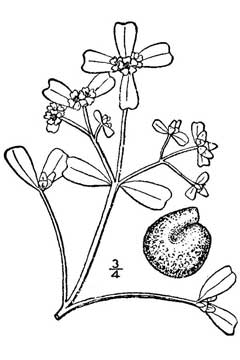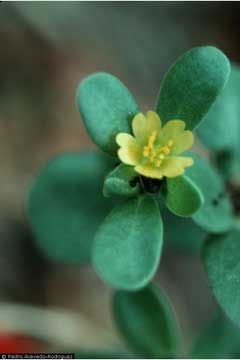 |
|
USDA-NRCS PLANTS Database / Britton, N.L., and A. Brown. 1913. An illustrated flora of the northern United States, Canada and the British Possessions. 3 vols. Charles Scribner's Sons, New York. Vol. 2 |
 |
| Pedro Acevedo-Rodriguez @ USDA-NRCS PLANTS Database |
Translate this page:
Summary
Physical Characteristics

 Portulaca retusa is a ANNUAL growing to 0.2 m (0ft 8in). It is in flower from June to September. The species is hermaphrodite (has both male and female organs) and is pollinated by Insects. The plant is self-fertile.
Portulaca retusa is a ANNUAL growing to 0.2 m (0ft 8in). It is in flower from June to September. The species is hermaphrodite (has both male and female organs) and is pollinated by Insects. The plant is self-fertile.
Suitable for: light (sandy) and medium (loamy) soils and prefers well-drained soil. Suitable pH: mildly acid, neutral and basic (mildly alkaline) soils. It cannot grow in the shade. It prefers dry or moist soil.
UK Hardiness Map
US Hardiness Map
Synonyms
Plant Habitats
Cultivated Beds;
Edible Uses
Edible Parts: Leaves Seed
Edible Uses:
Leaves - raw or cooked[61, 105, 161]. Seed - raw or cooked. Ground into a powder and used as a mush[161].
References More on Edible Uses
Medicinal Uses
Plants For A Future can not take any responsibility for any adverse effects from the use of plants. Always seek advice from a professional before using a plant medicinally.
None known
References More on Medicinal Uses
The Bookshop: Edible Plant Books
Our Latest books on Perennial Plants For Food Forests and Permaculture Gardens in paperback or digital formats.

Edible Tropical Plants
Food Forest Plants for Hotter Conditions: 250+ Plants For Tropical Food Forests & Permaculture Gardens.
More

Edible Temperate Plants
Plants for Your Food Forest: 500 Plants for Temperate Food Forests & Permaculture Gardens.
More

More Books
PFAF have eight books available in paperback and digital formats. Browse the shop for more information.
Shop Now
Other Uses
References More on Other Uses
Cultivation details
We have very little information on this species and do not know if it will succeed outdoors in Britain, though we feel it should be possible to grow it either as a hardy or a half-hardy annual. According to the Flora of N. America[270], this species is no more than a synonym of P. oleracea. The following notes are based on the general needs of the genus. Prefers a rather dry poor soil in full sun[1, 200].
References Carbon Farming Information and Carbon Sequestration Information
Temperature Converter
Type a value in the Celsius field to convert the value to Fahrenheit:
Fahrenheit:
The PFAF Bookshop
Plants For A Future have a number of books available in paperback and digital form. Book titles include Edible Plants, Edible Perennials, Edible Trees,Edible Shrubs, Woodland Gardening, and Temperate Food Forest Plants. Our new book is Food Forest Plants For Hotter Conditions (Tropical and Sub-Tropical).
Shop Now
Plant Propagation
Seed - sow spring in situ[200].
Other Names
If available other names are mentioned here
Native Range
Coming Soon
Weed Potential
Right plant wrong place. We are currently updating this section.
Please note that a plant may be invasive in one area but may not in your area so it's worth checking.
Conservation Status
IUCN Red List of Threatened Plants Status :

| Related Plants
|
| Latin Name | Common Name | Habit | Height | Hardiness | Growth | Soil | Shade | Moisture | Edible | Medicinal | Other |
| Calandrinia balonensis | | Annual/Perennial | 0.1 |
-
| | L | N | DM | 2 | 0 | |
| Calandrinia ciliata | Redmaids, Fringed redmaids | Annual | 0.2 |
6-10
| | LM | N | DM | 4 | 0 | 2 |
| Calandrinia ciliata menziesii | Redmaids | Annual | 0.1 |
-
| | L | N | DM | 2 | 0 | |
| Calandrinia polyandra | Parakeelya | Annual/Perennial | 0.1 |
-
| | LM | N | DM | 2 | 0 | |
| Calandrinia remota | | Annual/Perennial | 0.1 |
-
| | L | N | DM | 2 | 0 | |
| Claytonia acutifolia | Bering Sea Spring Beauty | Perennial | 0.2 |
-
| | LM | N | M | 3 | 0 | |
| Claytonia caroliniana | Broad-Leaved Spring Beauty, Carolina springbeauty | Perennial | 0.1 |
5-9
| | LM | N | M | 3 | 0 | 1 |
| Claytonia exigua | Pale Spring Beauty, Serpentine springbeauty | Annual | 0.1 |
0-0
| | LMH | FSN | DM | 2 | 0 | |
| Claytonia lanceolata | Lanceleaf Spring Beauty, Idaho springbeauty, Pacific springbeauty, Peirson's springbeauty | Perennial | 0.2 |
4-8
| | LM | N | M | 3 | 0 | |
| Claytonia megarhiza | Alpine Spring Beauty | Perennial | 0.2 |
4-8
| | LM | N | M | 3 | 0 | |
| Claytonia perfoliata | Miner's Lettuce | Annual | 0.2 |
6-10
| | LMH | FSN | DM | 4 | 1 | 2 |
| Claytonia scammaniana | Scamman's Claytonia, Scamman's springbeauty | Perennial | 0.2 |
0-0
| | LM | N | M | 2 | 0 | |
| Claytonia sibirica | Pink Purslane, Siberian springbeauty | Annual/Perennial | 0.2 |
3-7
| | LMH | FSN | DM | 4 | 1 | 3 |
| Claytonia tuberosa | Tuberous Spring Beauty | Perennial | 0.2 |
4-8
| | LM | N | M | 3 | 0 | |
| Claytonia umbellata | Great Basin Spring Beauty | Perennial | 0.2 |
-
| | LM | N | M | 2 | 0 | |
| Claytonia virginica | Spring Beauty, Virginia springbeauty, Hammond's claytonia, Yellow Virginia springbeauty | Perennial | 0.2 |
5-7
| M | LM | S | M | 3 | 1 | |
| Lewisia brachycalyx | Shortsepal lewisia | Perennial | 0.2 |
4-8
| S | LM | N | M | 2 | 0 | |
| Lewisia columbiana | Columbian Bitterroot, Columbian lewisia, Wallowa lewisia | Perennial | 0.2 |
4-8
| S | LM | SN | M | 2 | 0 | |
| Lewisia pygmaea | Pigmy Bitterroot, Alpine lewisia | Perennial | 0.1 |
3-7
| | LM | N | M | 2 | 0 | |
| Lewisia rediviva | Bitter-Root | Perennial | 0.1 |
4-8
| | LM | N | M | 2 | 2 | |
| Montia fontana | Water Blinks, Annual water minerslettuce | Annual/Perennial | 0.5 |
0-0
| | LMH | SN | MWeWa | 2 | 0 | |
| Portulaca grandiflora | Rose Moss | Annual | 0.2 |
-
| | LM | N | DM | 2 | 2 | |
| Portulaca oleracea | Green Purslane, Little hogweed | Annual | 0.3 |
3-12
| F | LM | N | M | 4 | 3 | 2 |
| Portulaca oleracea sativa | Golden Purslane | Annual | 0.3 |
-
| | LM | N | M | 4 | 3 | |
| Sesuvium portulacastrum | Sea Purslane, Shoreline seapurslane | Perennial | 0.2 |
8-10
| F | LMH | SN | M | 3 | 2 | 3 |
| Talinum aurantiacum | Orange Flameflower | Perennial | 0.4 |
-
| | LMH | SN | M | 1 | 0 | |
|
Growth: S = slow M = medium F = fast. Soil: L = light (sandy) M = medium H = heavy (clay). pH: A = acid N = neutral B = basic (alkaline). Shade: F = full shade S = semi-shade N = no shade. Moisture: D = dry M = Moist We = wet Wa = water.
Now available:
Food Forest Plants for Mediterranean Conditions
350+ Perennial Plants For Mediterranean and Drier Food Forests and Permaculture Gardens.
[Paperback and eBook]
This is the third in Plants For A Future's series of plant guides for food forests tailored to
specific climate zones. Following volumes on temperate and tropical ecosystems, this book focuses
on species suited to Mediterranean conditions—regions with hot, dry summers and cool, wet winters,
often facing the added challenge of climate change.
Read More
Expert comment
Author
Engelm.
Botanical References
43235270
Links / References
For a list of references used on this page please go here
Readers comment
| Add a comment |
|
If you have important information about this plant that may help other users please add a comment or link below. Only comments or links that are felt to be directly relevant to a plant will be included. If you think a comment/link or information contained on this page is inaccurate or misleading we would welcome your feedback at [email protected]. If you have questions about a plant please use the Forum on this website as we do not have the resources to answer questions ourselves.
* Please note: the comments by website users are not necessarily those held by PFAF and may give misleading or inaccurate information.
To leave a comment please Register or login here All comments need to be approved so will not appear immediately.
|
Subject : Portulaca retusa
|
|
|
|